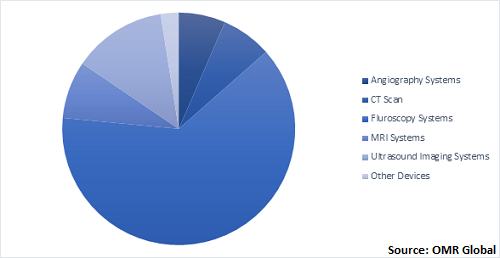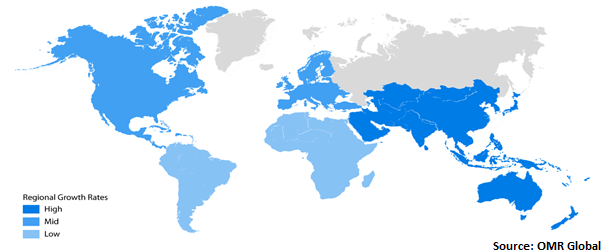Interventional Radiology Market
Global Interventional Radiology Market Size, Share & Trends Analysis Report by Diagnostic Modalities (Angiography Systems, CT Scan, Fluoroscopy Systems, MRI Systems, Ultrasound Imaging Systems and Others (Imaging Catheter Guidewires, C-ARM)), By Application (Cardiology, Oncology, Urology & Nephrology, Gastroenterology and Others (Orthopedics, Gynecology)), By Procedure (Angiography, Angioplasty, Biopsy and Drainage, Embolization, Thrombolysis, Vertebroplasty, Nephrostomy, Other Procedure) Forecast Period 2021-2027 Update Available - Forecast 2025-2035
The global interventional radiology market is anticipated to grow at a considerable CAGR of 6.5% during the forecast period (2021-2027). Interventional radiology is a technique that guides minimally invasive surgical procedures for the diagnosis and treatment of various diseases in nearly every organ system. The major factors that are augmenting the growth of the market include the rising geriatric population and increasing chronic diseases such as embolization and cancer. Besides, the rising trend and need for technologically advanced products such as minimally invasive technologies along with the collaboration of various interventional radiology organizations are some other factors that are estimated to fuel the growth of the market during the forecast period. Furthermore, the rise in awareness concerning radiology treatment in emerging economies such as India, China, Brazil, among more is also contributing towards the growth of the interventional radiology market. In these countries, the patient pool for cancer is increasing which is resulting in an increased need for radiology techniques, boosting the market growth.
On the other hand, certain factors that are negatively affecting the growth of the market include low adoption of digital technology-based systems, implementation of stringent regulatory procedures for approval, and high-cost treatment. Although, the emergence of cloud-based medical imaging and the increasing need for low pain and risk-free radiology techniques over open surgery procedures are some of the opportunities to capitalize on, during the forecast period.
Impact of COVID-19 on the Interventional Radiology Market
The interventional radiology market is expected to grow significantly with barely affected by the COVID-19 outbreak. The demand for CT scan, Chest X-ray, and ultrasound has enabled the continuous positive growth during the outbreak of COVID-19. The CT scan, Chest X-ray, and ultrasound has been used as diagnostic tools to analyze the pneumonia infection in the lungs apart from laboratory test (RT-PCR). Further, availability of point of care imaging solution has enabled healthcare profession to diagnose the condition of the COVID-19 patient without hospital visit. As imaging tools can be helpful in fighting against pandemic, the players are focused on developing wireless handheld imaging tools to reduce the spread of infection and enable easy diagnosis. For instance, Butterfly iQ, a new generation of handheld ultrasound devices developed by Butterfly Network, allows faster assessment of pulmonary symptoms of the disease, while minimizing the spread of COVID-19 by reducing the need to move patients and equipment during the treatment process.
Segmental Outlook
The market is segmented based on product, application, and procedure. By product, the market is segmented into angiography systems, CT scan, fluoroscopy systems, MRI systems, ultrasound imaging systems, and others (imaging catheter guidewires, C-ARM). Based on the application segment, the market is segmented into cardiology, oncology, urology & nephrology, gastroenterology, and others (orthopedics and gynecology). Based on the procedure segment, the market is segmented into angiography, angioplasty, biopsy and drainage, embolization, thrombolysis, vertebroplasty, nephrostomy, and other procedures (fallopian tube recanalization, cholecystectomy).

Among the procedure segment, the angiography system category holds a major market share in 2020. The angiography system market growth is driven by an increase in patient safety and ensured faster recovery provided by these systems. It also aids in eliminating the need for cost-intensive invasive surgeries due to which, medical professionals are increasingly adopting minimally invasive surgical procedures over conventional open procedures. Some of the major angiography system treatment providers include Koninklijke Philips N.V., Siemens Healthcare, Canon Medical Systems Inc., among more. Further, the rising prevalence of cardiovascular diseases is expected to contribute to the segment growth.
Regional Outlooks
Geographically, the global interventional radiology market is analyzed into North America, Europe, Asia Pacific, and the Rest of the World. North America is estimated to be the leading region for the global interventional radiology market. Technological advancements and the rising geriatric population are the major factors driving the growth of the market in North America. While, Asia-Pacific is estimated to be the fastest-growing market during the forecast period, due to the rise in healthcare expenditures and increasing prevalence of chronic diseases as well as population increase in emerging countries including China and India.
Global Interventional Radiology Market Growth, by Region 2021-2027

Market Players Outlook
Key players operating in the interventional radiology market include Siemens Healthcare, Medtronic plc, GE Healthcare, Koninklijke Philips N.V., Agfa-Gevaert Group, Fujifilm Holdings Corp., Carestream Health, and Hologic Corp, among more. To survive in the market these players adopt different marketing strategies such as a merger, acquisitions, product launch, and geographical expansion so on. For Instance, in August 2019, Philips completed the acquisition of Carestream Health’s Healthcare Information Systems business in 26 of the 38 countries in which it operates. Carestream HCIS’s cloud-enabled enterprise imaging platform expanded Philips’ enterprise diagnostic informatics solutions, including productivity enhancement, imaging data management, and advanced visualization and analysis. In addition, in August 2020, Philips acquired Intact Vascular for $275M to expand its minimally invasive therapy options for peripheral artery disease with the Tack endovascular system.
The Report Covers
- Market value data analysis of 2020 and forecast to 2027.
- Annualized market revenues ($ million) for each market segment.
- Country-wise analysis of major geographical regions.
- Key companies operating in the global interventional radiology market. Based on the availability of data, information related to new product launches, and relevant news is also available in the report.
- Analysis of business strategies by identifying the key market segments positioned for strong growth in the future.
- Analysis of market-entry and market expansion strategies.
- Competitive strategies by identifying ‘who-stands-where in the market.


